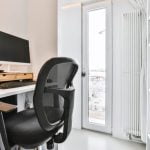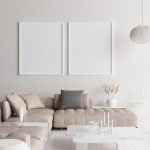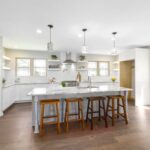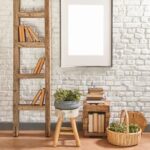Are you looking to elevate your home decor but feeling overwhelmed with ideas? Learn how to make a home decorating mood board and take the guesswork out of designing your space.
A mood board is a visual tool that can help you gather and organize inspiration, select color palettes, and bring your design vision to life. In this article, we will guide you through the process of creating a mood board for your home decorating projects, and explore its significance in achieving a cohesive and visually appealing interior design.
When it comes to transforming a space, having a clear vision is key. This is where a mood board becomes an essential asset in the home decorating process. By carefully curating images, textures, and colors that inspire you, you can map out the aesthetic direction for your project. The benefits of creating a mood board extend beyond just gathering ideas; it serves as a roadmap for decision-making, ensuring that every element of your design works together harmoniously.
The purpose of this article is to demonstrate how a well-crafted mood board can be a powerful tool in guiding your home decor journey. From understanding the role of a mood board to gathering inspiration and organizing ideas, we will explore the step-by-step process of creating an effective visual reference for your home decorating endeavors.
Whether you are embarking on a complete room makeover or simply refreshing the look of your space, learning how to make a home decorating mood board will undoubtedly enhance the success and satisfaction of your design project.
Understanding the Purpose of the Mood Board
When it comes to home decorating, the use of a mood board can be an invaluable tool in visualizing and planning decor ideas. The purpose of a mood board is to gather and display inspiration, materials, and design elements in one cohesive and visually appealing format. By creating a mood board, homeowners can effectively communicate their vision for their space, make informed design decisions, and maintain a consistent aesthetic throughout the decorating process.
Visualizing and Planning Home Decor Ideas
One of the primary purposes of a mood board is to help individuals visualize and plan their home decor ideas. By collecting images, fabric swatches, paint samples, and other materials on a mood board, homeowners can see how different elements work together in one unified composition. This allows them to experiment with various design combinations before committing to any specific choices, ultimately leading to a more thoughtfully curated space.
A well-organized mood board can also aid in decision-making throughout the decorating process. When faced with numerous options for furniture, color schemes, or accessories, referring back to the mood board can provide clarity and direction. It serves as a reference point for ensuring that each design choice aligns with the overall vision for the space. Furthermore, it can prevent impulse purchases or design choices that may disrupt the cohesive look of the room.
Maintaining a Cohesive Design Aesthetic
Lastly, the purpose of a mood board is to help maintain a cohesive design aesthetic within a home. Whether it’s adhering to a specific color palette or ensuring that decor elements complement each other stylistically, having all design ideas visually represented on a mood board allows homeowners to assess how well they harmonize with one another. This process helps create spaces that feel harmonious and intentional rather than disjointed or disconnected.
Gathering Inspiration
When it comes to creating a mood board for home decorating, gathering inspiration is a crucial first step. This process involves seeking out various sources of design ideas and styles that resonate with your personal taste and the aesthetic you want to achieve in your space.
One effective way to gather inspiration for your mood board is by utilizing online platforms such as Pinterest, where you can create digital “boards” to collect images, color palettes, and decor concepts that inspire you.
In addition to online resources, design magazines and home decor blogs are valuable sources of inspiration for creating a mood board. These publications often feature beautifully curated spaces, unique color combinations, and innovative design elements that can spark creativity and provide fresh ideas for your own decorating project. By collecting diverse sources of inspiration from different mediums, you can ensure that your mood board reflects a well-rounded vision for your home decor.
Furthermore, it’s important to pay attention to the specific elements within each source of inspiration that catch your eye. Whether it’s a particular piece of furniture, a wall treatment, or a decorative accessory, identifying these individual details will help you refine your overall vision for the mood board. Taking note of these details and analyzing why they appeal to you will ultimately guide the direction of your home decorating project.
Choosing a Theme or Color Palette
When it comes to home decorating, one of the most crucial steps is choosing a theme or color palette. The theme or color scheme sets the tone for the entire design and helps create a cohesive look throughout the space. Whether you prefer a monochromatic, minimalist aesthetic or a bold, eclectic style, selecting the right theme or color palette is essential for achieving your desired home decor vision.
Before delving into the process of choosing a theme or color palette, it’s important to consider the mood and atmosphere you want to create in your home. Do you want a serene and calming ambiance in your living room? Or perhaps a vibrant and energetic feel in your kitchen? By understanding the desired mood for each space, you can narrow down your options and make more informed decisions when selecting a theme or color palette.
Once you’ve established the mood for each room, start exploring different themes and color palettes that align with your vision. Look for inspiration in various sources such as interior design magazines, online platforms like Pinterest, and even nature or art pieces. Pay attention to patterns, textures, and colors that resonate with you, and consider how these elements can be incorporated into your home decor.
As you gather inspiration, keep in mind that the chosen theme or color palette should complement the existing elements in your home, such as furniture, flooring, and architectural features. The goal is to create a harmonious balance between these components and the new decor elements.
Additionally, consider how lighting plays a role in showcasing different colors and patterns within the space. By carefully considering these factors, you can ensure that your chosen theme or color palette enhances the overall aesthetic of your home.
This section discussed how to choose a theme or color palette for your home decorating project. By understanding the desired mood for each room and gathering diverse sources of inspiration, you can effectively select a theme or color scheme that aligns with your vision. In the next section we’ll delve into how to collect materials needed for creating a physical mood board along with alternative options for digital mood boards using online tools and software.
Collecting Materials
Creating a mood board for home decorating projects involves gathering materials that will best represent the vision and aesthetic you want to achieve in your space. Whether you opt for a physical or digital mood board, the process of collecting materials is crucial in bringing your design ideas to life.
In this section, we will discuss the types of materials needed to create a physical mood board, as well as alternative options for creating digital mood boards using online tools and software.
For a physical mood board, you will need supplies such as magazines, scissors, glue, and a foam board or poster board. These items will allow you to cut out images and textures that inspire you and arrange them on a board to visually convey your design concept. Additionally, fabric swatches, paint samples, and small decor items can be added to the physical mood board to provide tactile elements and further illustrate the desired look for your space.
If you prefer to create a digital mood board, there are numerous online tools and software available that make the process seamless. Websites like Pinterest allow users to create virtual mood boards by saving images from around the web that resonate with their design style.
Design software such as Adobe Photoshop or Canva also offer templates and tools specifically designed for creating digital mood boards. These platforms give users access to an extensive library of images and graphics to curate a visually stunning representation of their home decor ideas.
Whichever method you choose, the key is to gather materials that truly speak to your personal taste and vision for your home decor project. By carefully selecting images, textures, colors, and patterns that resonate with you, you can effectively communicate the look and feel you want to achieve in your space.
Arranging and Organizing Ideas
Creating a mood board for home decorating is an essential step in the design process. It allows you to visualize your ideas and plan out the look and feel of your space before making any major decisions or purchases. When it comes to arranging and organizing ideas on your mood board, there are a few key tips to keep in mind.
First, start by gathering all of the materials and inspiration you’ve collected for your mood board. This could include magazine clippings, fabric swatches, paint samples, and any other visual elements that represent the style and aesthetic you want to achieve in your home. Once you have everything gathered, it’s time to arrange them in a way that makes sense visually.
Here are some tips for arranging and organizing your ideas on your mood board:
- Start by laying out all of your materials on a flat surface so you can see everything at once.
- Consider creating sections or groupings based on themes, colors, or specific rooms within your home.
- Play around with different arrangements until you find a layout that feels cohesive and visually appealing.
- Use adhesive to secure everything in place once you’re happy with the layout.
By following these tips, you can ensure that your mood board accurately represents the vision you have for your home decor project.
Additionally, consider the importance of balance, proportion, and visual hierarchy when arranging elements on your mood board. You want to create a sense of harmony and flow within the design, so pay attention to how different elements interact with each other. For example, if you have a bold patterned fabric swatch, pair it with more subtle imagery or textures to create contrast and balance on the mood board.
Overall, arranging and organizing ideas on your mood board is an important step in the home decorating process. By taking the time to carefully curate and arrange your materials, you’ll have a clear visual representation of your design vision to guide you through the rest of the project.
Adding Texture and Dimension
When it comes to creating a mood board for home decorating, adding texture and dimension is an important step in accurately representing the intended decor elements. By incorporating tactile materials and visual depth, you can bring your design ideas to life and create a more immersive and realistic representation of your vision. Here are some tips for adding texture and dimension to your home decorating mood board:
- Incorporate fabric swatches: Adding fabric swatches to your mood board can provide a sense of texture and materiality. Whether it’s the softness of velvet, the nubbly texture of tweed, or the smoothness of silk, including fabric samples can give a tactile element to your design concept.
- Include paint samples: If color is an important aspect of your home decor project, consider including paint samples on your mood board. Not only does this add visual interest, but it also allows you to see how different colors interact with each other in the context of your overall design.
- Use 3D elements: To further enhance the dimension of your mood board, consider incorporating three-dimensional elements such as small objects or architectural materials that reflect the style you’re trying to achieve. This could include small vases, decorative figurines, or even architectural moldings if they align with your design theme.
By incorporating these elements into your home decorating mood board, you can create a more comprehensive representation of your design ideas that goes beyond mere visuals. Whether you’re creating a physical or digital mood board, adding texture and dimension can elevate the process and help you better visualize the end result of your home decor project.
Using the Mood Board in Your Decorating Process
Using a mood board in the home decorating process can significantly streamline and enhance the overall design experience. Once you have put together an inspiring mood board, it’s time to put those ideas into action and bring your vision to life. In this section, we will delve into how to effectively use your mood board as a practical tool throughout the decorating process.
Reference and Inspiration
The primary function of a mood board during the decorating process is to serve as a point of reference and inspiration. As you begin implementing your decor ideas, refer back to your mood board to keep your vision on track. Whether you’re shopping for furniture, selecting paint colors, or choosing textiles, having a visual representation of your design concept can help make decisions with confidence.
Decision-Making Guide
As you encounter choices and options during the decorating process, consult your mood board to ensure that each decision aligns with the overall aesthetic you have envisioned. Whether it’s deciding on artwork for the walls or selecting accent pieces for the room, use your mood board as a guide to maintain consistency and cohesiveness in your design choices.
Progress Tracking
Additionally, using your mood board as a progress-tracking tool can help visualize how elements come together in real-time. As you make selections and implement design changes, update your mood board accordingly to create a comprehensive visual record of the entire decorating process. This can be especially valuable when working on multi-room projects or larger-scale renovations as it allows you to see how each room’s design ties into the overarching theme of your home.
By understanding how to effectively use a mood board in the home decorating process-referencing it for inspiration, decision-making guidance, and progress tracking-you can maximize its utility as a practical tool for bringing your interior design vision to life. With your personalized mood board at hand throughout the process, you’ll have a clear and cohesive roadmap for creating a beautifully designed living space that reflects your unique style and taste.
Conclusion
In conclusion, creating a mood board for home decorating projects is a valuable and essential tool for visualizing and planning the design aesthetic of a space. By understanding the purpose of a mood board and gathering diverse sources of inspiration, individuals can effectively capture their vision for their home decor project.
Choosing a theme or color palette, as well as collecting materials to create the mood board, are crucial steps in the process that contribute to maintaining a cohesive design aesthetic.
Arranging and organizing ideas on the mood board with balance, proportion, and visual hierarchy, as well as adding texture and dimension to represent intended decor elements, further enhance the effectiveness of the mood board as a reference throughout the home decorating process. By utilizing the tips and techniques discussed in this article, individuals can confidently create their own personalized mood boards for their home decor endeavors.
Ultimately, a well-crafted mood board not only serves as a guide for decision-making but also acts as an ongoing source of inspiration throughout the home decorating journey. It allows individuals to visually map out their ideas and preferences while ensuring that they stay true to their desired design aesthetic.
The benefits of creating a mood board are evident in its ability to bring cohesiveness to an interior space and serve as a tangible representation of one’s vision for their home decor project.
Frequently Asked Questions
How Do You Make a Mood Board for a House?
Making a mood board for a house involves gathering inspiration from various sources such as magazines, Pinterest, and online images. You can then arrange these inspiration materials on a board to create a visual representation of the desired mood or style for the house.
What Do Interior Designers Use for Mood Boards?
Interior designers use a variety of materials for mood boards, including fabric swatches, paint chips, flooring samples, and wallpaper samples. They may also include photographs, sketches, and magazine cutouts to convey the overall aesthetic they want to achieve in a space.
What Program Do You Use to Make a Moodboard?
There are several programs that can be used to make a moodboard, such as Adobe Photoshop, Illustrator, or InDesign. Canva and Milanote are other popular digital platforms that allow users to easily create and customize mood boards using pre-made templates and design tools.

I’m thrilled to be your companion on this exciting journey through the world of home decor and design. With a passion for turning houses into homes and a keen eye for the finer details, I’m here to help you transform your living spaces into beautiful, functional, and meaningful havens.





